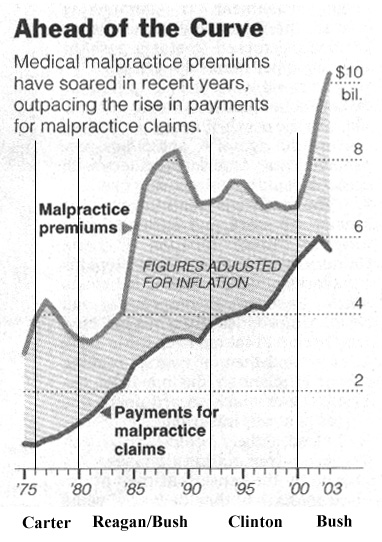Source: "Leading by misleading" by Molly Ivins - Creators Syndicate - 01.11.05
[T]ucked like a gleaming diamond in the proposed legislation to curb malpractice lawsuits is a provision that would give an unconscionable degree of protection to firms responsible for drugs or medical devices that turn out to be harmful.
The provision would go beyond caps on certain damages. It would actually prohibit punitive damages in cases in which the drug or medical device had received Food and Drug Administration approval.
"Now primarily a marketing machine to sell drugs of dubious benefit," she wrote, "this industry uses its wealth and power to co-opt every institution that might stand in its way, including the U.S. Congress, the Food and Drub Administration, academic medical centers, and the medical profession itself. (Most of its marketing efforts are focused on influencing doctors, since the must write the prescriptions.)"
Source: "A Gift for Drug Makers" by Bob Herbert - New York Times - 1/14/05
Malpractice Payouts Declined as Insurance Premiums Spiked; 5.2 Percent of Doctors Are Responsible for 55 Percent of Malpractice Payouts
New government data show that both the number and amount of payments to medical malpractice victims declined in 2002, casting further doubt on the assertion that lawsuits are responsible for doctorsí insurance premium increases.
The number of medical malpractice payouts decreased by 8.2 percent, from 16,669 in 2001 to 15,304 in 2002, according to a Public Citizen analysis of new National Practitioner Data Bank (NPDB) records for last year. The total damages paid to victims declined by 6.9 percent, from $4.5 billion in 2001 to $4.2 billion in 2002, the analysis found. When adjusted for medical services inflation in 2002 the decline was even more dramatic Ė 11.2 percent. The cost of medical care typically represents the greatest cost in a medical malpractice payout.
The number of awards greater than $1 million decreased by 11.5 percent, from 454 in 2001 to 402 in 2002. The data bank, a U.S. government agency, collects reports of every judgment or settlement paid to malpractice victims throughout the country by insurance companies on behalf of doctors.
According to Public Citizenís analysis of NPDB data, a small percent of doctors are responsible for more than half of all malpractice payments, yet disciplinary actions (license suspension or revocation, or a limit on clinical privileges) for these doctors have been few and far between. The data showed that:
Just 5.2 percent of doctors made two or more malpractice payouts and were responsible for 55 percent of all payouts between 1990 and 2002. Just 1.1 percent of all doctors have made three or more malpractice payouts, amounting to 30 percent of all malpractice payouts.
Only 10.7 percent (1,401 of 13,182) of all doctors who made three or more malpractice payouts have been disciplined. Only 16.9 percent (488 of 2,896) of those doctors who made five or more malpractice payouts have been disciplined.
"Itís clear from these numbers that the insurance premium increases over the past year are not tied to lawsuits," said Joan Claybrook, president of Public Citizen. "The only thing that correlates with the premium increases is the decline in malpractice insurersí investment income."
The U.S. Senate [voted Wednesday, July 9, 2003] on legislation that would significantly limit patientsí ability to hold medical providers accountable for negligence...The billís proponents claim that malpractice insurance rates are rising because of malpractice awards to patients, but all available data show that the legal system has no impact on insurance rates. Rather, insurance rates are tied to investment returns from the bond and stock markets and to the competitive economics of the insurance cycle.
Source: Public Citizen - "New 2002 Government Data Dispute Malpractice Lawsuit 'Crisis' " - July 7, 2003
The goal could have been better promoted by fighting devastating cuts in Medicaid and the children's health insurance program or by the governor simply signing "prompt pay" legislation. Access to care is being limited by the growing number of uninsured patients and the falling number of eligible Medicaid and Medicare patients. Access also is being strangled by insurers that refuse to reimburse providers on time.
Proposition 12 [Texas award limit ballot initiative] has little to do with malpractice premiums and everything to do with limiting the liability of drug manufacturers, polluters, big insurance companies and other defendants. Those interest groups are riding on the backs of doctors to sneak constitutional changes past the voters.
Source: Dallas Morning News -- Two diagnoses of Prop 12 -- editorial by Houston physician Dr. David Marrack - 9/7/03
Randall R. Bovbjerg, a researcher at the Urban Institute, said, "If you take the worst performers out of practice, that will have an impact" on malpractice litigation. "most doctors have few or no claims filed against them," he added. "But within any specialty, a few doctors have a high proportion of the claims."
In Massachusetts in the last 10 years, Nancy Achin Audesse, executive director of the Massachusetts Board of Registration in Medicine said: "one-fourth of 1 percent of all the doctors -- 98 of the 37,369 doctors -- accounted for more than 13 percent of all the malpractice payments, $134 million of the $ 1 billion in total payments."
Source: "Panel Seeks Better Diciplining of Doctors" by Robert Pear - New York Times - 1/5/05
The cost of medical malpractice insurance continues to rise, while the amount paid to medical malpractice victims declines.
While a significant portion of medical malpractice payouts can be attributed to a small number of doctors, the medical community and the insurance industry routinely fail to exclude these doctors from the profession.
Instead, there appears to be a correlation between the cost of medical malpractice insurance and a decrease in insurance company profits from the stock market.
For what American companies and individuals pay for insurance premiums, we could finance a single-payer insurance system based on the Medicare system that covers all Americans.

Source: A.M. Best via New York Times - 2/23/05